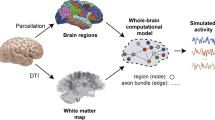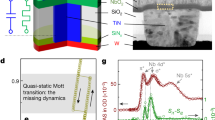Abstract
We demonstrate that a previously presented flexible silicon–neuron architecture can implement three disparate conductance-based neuron models with both fast and slow dynamics. By exploiting the real-time nature of this physical implementation, we mapped the model dynamics across a large region of parameter space. We also found that two of these dynamically different models represent points in a contiguous bursting space that spans between the two models. By systematically varying the model parameters, we also found that multiple, diverse trajectories in parameter space connected the two canonical bursting points. In addition, we found that the combination of parameter values keeps the neuron in the bursting region. These findings demonstrate the usefulness of the silicon–neuron architecture as a neural-modeling tool and illustrate its versatility as a platform for a multi-behavioral neuron that resembles its living analog.
Similar content being viewed by others
References
Bragg JA, Brown E, Hasler P, DeWeerth SP (2002) A silicon model of an adapting motoneuron. In: 2002 IEEE international symposium on circuits and systems, IEEE Circuits and Systems Society, IEEE, Scottsdale, AZ, vol 4, pp 261–264
Butera R Jr, Rinzel J, Smith JC (1999) Models of respiratory rhythm generation in the Pre-Bötzinger complex. I. Bursting pacemaker neurons. J Neurophysiol 82(1):382–397
Connor J, Stevens C (1971) Voltage clamp studies of a transient outward membrane current in gastropod neural somata. J Physiol 213(1):21–30
Cymbalyuk GS, Patel GN, Calabrese RL, DeWeerth SP, Cohen AH (2000) Modeling alternation to synchrony with inhibitory coupling: a neuromorphic VLSI approach. Neural Comput 12(10):2259–2278
Darghouth N (2004) Modeling A-current modulation in an identified molluscan neuron. Master’s thesis, Georgia Institute of Technology, Atlanta, GA
Foster W, Ungar L, Schwaber J (1993) Significance of conductances in Hodgkin–Huxley models. J Neurophysiol 70(6):2502–2518
Getting PA (1983) Mechanisms of pattern generation underlying swimming in Tritonia. III. Intrinsic and synaptic mechanisms for delayed excitation. J Neurophysiol 49:1036–1050
Golowasch J, Goldman MS, Abbott L, Marder E (2002) Failure of averaging in the construction of a conductance-based neuron model. J Neurophysiol 87:1129–1131
Graas E, Brown E, Lee RH (2004) An FPGA-based approach to high-speed simulation of conductance-based neuron models. Neuroinformatics 2(4):417–436
Hahnloser R, Sarpeshkar R, Mahowald M, Douglas R, Seung H (2000) Digital selection and analogue amplification coexist in a cortex-inspired silicon circuit. Nature 405(6789):947–951
Hill A, Lu J, Masino M, lsen O, Calabrese R (2001) A model of a segmental oscillator in the leech heartbeat neuronal network. J Computat Neurosci 10(3):281–302
Hille B (2001) Ion channels of excitable membranes, 3rd edn. Sinauer Associates Inc,. Sunderland MA
Hodgkin A, Huxley A (1952) A quantitative description of membrane current and its application to conduction and excitation in nerve. J Physiol (London) 117:500–544
Kandel ER, Schwartz JH, Jessell TM (eds) (2000) Principles of neural science, 4th edn. McGraw-Hill/Appleton & Lange, New York, NY
Krinskii V, Kokoz Y (1973) Analysis of equations of excitable membranes. I. Reducing of Hodgkin–Huxley equations to system of second-order. Biofizika 18:506–511
Liu SC, Kramer J, Indiveri G, Delbrück T, Douglas R (2002) Analog VLSI: circuits and principles. The MIT Press, Cambridge
Mahowald MA, Douglas R (1991) A silicon neuron. Nature 354(6354):515–518
Marder E, Calabrese RL (1996) Principles of rhythmic motor pattern generation. Physiol Rev 76(3):687–717
Marder E, Prinz AA (2002) Modeling stability in neuron and network function: the role of activity in homeostasis. BioEssays 24(12):1145–1154
Mead CA (1989) Analog VLSI and neural systems. Addison-Wesley, Reading
Nadim F, Ølsen O, Schutter ED, Calabrese R (1995) Modeling the leech heartbeat elemental oscillator: I. Interactions of intrinsic and synaptic currents. J Comput Neurosci 2(3):215–235
Patel G, Brown E, DeWeerth SP (2000) A neuromorphic VLSI system for modeling the neural control of axial locomotion. In: Solla SA, Leen TK, Müller KR (eds) Advances in neural information processing systems, vol 12 Proceedings of the 1999 conference. The MIT Press, Cambridge, pp 724–730
Pearson K (2000) Neural adaptation in the generation of rhythmic behavior. Annu Rev Physiol 62:723–753
Prinz AA, Billimoria CP, Marder E (2003) Alternative to hand-tuning conductance-based models: construction and analysis of databases of model neurons. J Neurophysiol 90:3998–4015
Rinzel J (1985) Excitation dynamics: insights from simplified membrane models. Fed Proc 44(15):2944–2946
Sarpeshkar R, Lyon RF (1998) A low-power wide-dynamic-range analog VLSI cochlea. Analog integrated circuits and signal processing 16(3):245–274
Simoni MF, Cymbaluyk GS, Sorensen MQ, Calabrese RL, DeWeerth SP (2001) Development of hybrid systems: interfacing a silicon neuron to a leech heart interneuron. In: Leen T, Dietterich T, Tresp V (eds) Advances in neural information processing systems, vol 13, Proceedings of the 2000 conference. The MIT Press, Cambridge
Simoni MF, Cymbaluyk GS, Sorensen ME, Calabrese RL, DeWeerth SP (2004) A multiconductance silicon neuron with biologically matched dynamics. IEEE Trans Biomed Eng 51(2):342–354
Sorensen M, Calabrese R, DeWeerth S (2004) The functional role of model complexity in a neuronal oscillator. In: 2004 Abstract viewer/itinerary planner, Society for Neuroscience, Washington, DC, program No. 420.6
Weinstein R, Lee R (2004) Computationally intensive motoneuron modeling in FPGAs. In: 2004 Abstract viewer/itinerary planner, Society for Neuroscience, Washington, DC, program No. 921.5
Weisstein EW (2004) Hypergeometric distribution. MathWorld—a Wolfram Web resource, http://www.mathworld. wolfram.com/HypergeometricDistribution.html
Author information
Authors and Affiliations
Corresponding author
Rights and permissions
About this article
Cite this article
DeWeerth, S.P., Reid, M.S., Brown, E.A. et al. A comparative analysis of multi-conductance neuronal models in silico . Biol Cybern 96, 181–194 (2007). https://doi.org/10.1007/s00422-006-0111-7
Received:
Accepted:
Published:
Issue Date:
DOI: https://doi.org/10.1007/s00422-006-0111-7




